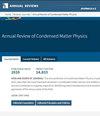Director Deformations, Geometric Frustration, and Modulated Phases in Liquid Crystals
IF 30.7
1区 物理与天体物理
Q1 PHYSICS, CONDENSED MATTER
Annual Review of Condensed Matter Physics
Pub Date : 2021-03-05
DOI:10.1146/annurev-conmatphys-031620-105712
引用次数: 30
Abstract
This article analyzes modulated phases in liquid crystals, from the long-established cholesteric and blue phases to the recently discovered twist-bend, splay-bend, and splay nematic phases, as well as the twist-grain-boundary (TGB) and helical nanofilament variations on smectic phases. The analysis uses the concept of four fundamental modes of director deformation: twist, bend, splay, and a fourth mode related to saddle-splay. Each mode is coupled to a specific type of molecular order: chirality, polarization perpendicular and parallel to the director, and octupolar order. When the liquid crystal develops one type of spontaneous order, the ideal local structure becomes nonuniform, with the corresponding director deformation. In general, the ideal local structure is frustrated; it cannot fill space. As a result, the liquid crystal must form a complex global phase, which may have a combination of deformation modes, and may have a periodic array of defects. Thus, the concept of an ideal local structure under geometric frustration provides a unified framework to understand the wide variety of modulated phases. Expected final online publication date for the Annual Review of Condensed Matter Physics, Volume 13 is March 2022. Please see http://www.annualreviews.org/page/journal/pubdates for revised estimates.液晶中的定向变形、几何挫折和调制相位
本文分析了液晶中的调制相,从长期建立的胆甾醇相和蓝相,到最近发现的扭曲弯曲、张开弯曲和张开向列相,以及近晶相上的扭曲晶界(TGB)和螺旋纳米丝的变化。该分析使用了指向矢变形的四种基本模式的概念:扭曲、弯曲、张开,以及与鞍形张开相关的第四种模式。每种模式都与一种特定类型的分子序耦合:手性、垂直和平行于指向矢的偏振以及八极序。当液晶发展出一种自发有序时,理想的局部结构变得不均匀,并伴有相应的指向矢变形。一般来说,理想的局部结构会受挫;它无法填充空间。因此,液晶必须形成复杂的全局相,其可能具有变形模式的组合,并且可能具有缺陷的周期性阵列。因此,几何挫折下的理想局部结构的概念为理解各种调制相位提供了一个统一的框架。《凝聚态物理学年度评论》第13卷预计最终在线出版日期为2022年3月。请参阅http://www.annualreviews.org/page/journal/pubdates用于修订估算。
本文章由计算机程序翻译,如有差异,请以英文原文为准。
求助全文
约1分钟内获得全文
求助全文
来源期刊

Annual Review of Condensed Matter Physics
PHYSICS, CONDENSED MATTER-
CiteScore
47.40
自引率
0.90%
发文量
27
期刊介绍:
Since its inception in 2010, the Annual Review of Condensed Matter Physics has been chronicling significant advancements in the field and its related subjects. By highlighting recent developments and offering critical evaluations, the journal actively contributes to the ongoing discourse in condensed matter physics. The latest volume of the journal has transitioned from gated access to open access, facilitated by Annual Reviews' Subscribe to Open initiative. Under this program, all articles are now published under a CC BY license, ensuring broader accessibility and dissemination of knowledge.
 求助内容:
求助内容: 应助结果提醒方式:
应助结果提醒方式:


